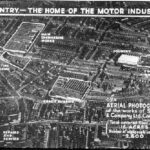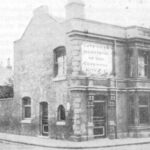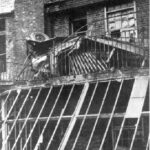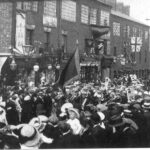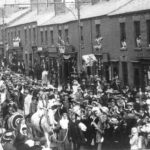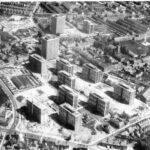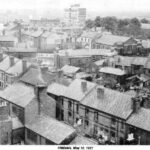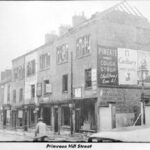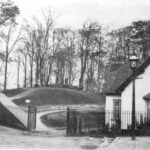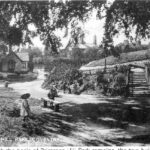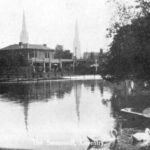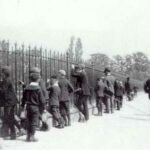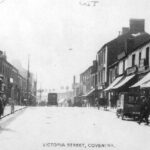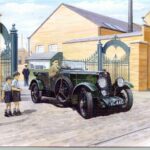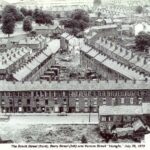Homepage » Hillfields
Hillfields
Hillfields was established in 1828 as the first suburb of Coventry when the city expanded outside the city walls. Before then it was known as Harnall. The district was at first called the New Town. Development was rapid during the remainder of the 19th Century and the district was very important in Coventry’s industrial and social history.
It was the home to significant parts of the City’s weaving, bicycle, motor cycle and car industries. Development of the New Town began in 1828 but it was separated from the city by the River Sherbourne which was obstructed by two mills which caused it to flood. These mills could not be pulled down until an Act of Parliament was obtained in 1844. When this was done, the Ford Street and Lower Ford Street area could be developed and the old city joined to the new town.
Between 1841 and 1861 the majority of the 2000 houses built in Coventry were built in Hillfields – the ribbon weaver’s new town. The standard of living of those moving to Hillfields was much higher than those remaining in the slums of the city. Hillfields became the home, not only of many of the upper class of freemen weavers, but of his cottage factory, while the old city became the home of the lower class of weavers and of the factory.
The industry in the New Town was initially a cottage industry with individual weaving workshops located above residential properties in “topshops” and there were many in the district. Steam engines at the end of the row of weaver’s houses, conducted the power with shafting from one workshops to another. The cottage factory became a serious alternative to the factory. The most famous of these was the triangle of 67 cottage homes with top shops for looms built by Eli Green at Vernon Street / Berry Street / Brook Street in 1858. There was a central steam engine in the middle of the development. The craftsmen worked on Eli Green’s materials and sold him the finished ribbons and also paid rent for the power used. Sadly this triangle of topshops was demolished by the Council in the 1970s.
As well as craft workshops, several weaving factories were eventually developed in Hillfields. The Stevengraph Factory was the most famous of Hillfields weaving factories and their woven pictures are still collectors’ items. As well as weaving there was also an elastic web industry and a range of ancillary companies, such as loom manufacturers.
Hillfields was also the home of Coventry City Football Club for most of its life. It was established as the Singer Football Club in 1883, named after the local cycle manufacturer for which most of the team worked. It became Coventry FC in 1898 and moved to Highfields Road the following year. It remained there until 2005 when the club relocated to the Ricoh Arena in Longford. The Highfield Road site has since been redeveloped for housing.
In the early years of the twentieth century, Hillfields played a key part in the development of Coventry’s Car Industry. In total there were 20 different car makers located in Hillfields including Lea Francis, Singer, Hillman and Humber.
Hillfields, being an industrial area was the target of air raids during the Second World War and suffered badly from bomb damage, including Coventry and Warwickshire Hospital, the Stevenograph Works, shops and many houses: 192 houses were totally destroyed or had to be demolished and 1435 houses were seriously damaged.
Following the war there was a big job to do to restore the area. The Town and Country Planning Act 1944 allowed Local Authorities to declare Areas of Comprehensive Development. Hillfields was one of three prepared in the1940s (the others were the central area and Spon End) it having suffered through decay and wartime bombing.
In the Development Plan of 1951 Hillfields was designated as a “Comprehensive Development Area” (CDA) with the local authority being able to exercise Compulsory Purchase Order (CPO) powers. By 1961 it was recorded that 53% of houses in Hillfields were likely to be declared unfit within the next five years. Work began on the CDA at the beginning of the 1960s.
Work on the CDA continued into the 1970s and eventually 13 blocks of flats were built in Hillfields with much of the older parts of Hillfields were comprehensively redeveloped. But there was a change in policy in the early 1970s and emphasis was placed on retaining and modernising the older houses. Hillfields was at the forefront of this change of policy with the country’s first General Improvement Area (GIA) being designated at Colchester Street / Winchester Street in an area previously earmarked for clearance. The powers gave the opportunity for local residents to declare their own GIA and the country’s first resident declared GIA was established at Hartlepool, Redcar, Stockton Road (HRS).
In recent years many of the Hillfields Flats have been redeveloped to allow the building of the new City College buildings. The Coventry and Warwick Hospital has closed and moved to Walsgrave. Hillfields remains one of the most disadvantaged neighbourhood in England.




